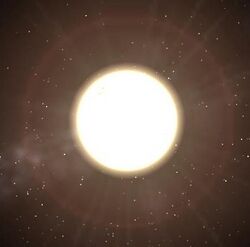Astronomy:HD 129445
From HandWiki
Short description: Star in the constellation Circinus
| Observation data Equinox J2000.0]] (ICRS) | |
|---|---|
| Constellation | Circinus |
| Right ascension | 14h 46m 03.06521s[1] |
| Declination | –68° 45′ 45.8797″[1] |
| Apparent magnitude (V) | 8.80[2] |
| Characteristics | |
| Spectral type | G6V[3] |
| Apparent magnitude (B) | 9.556[2] |
| Apparent magnitude (J) | 7.531±0.023[2] |
| Apparent magnitude (H) | 7.243±0.027[2] |
| Apparent magnitude (K) | 7.167±0.026[2] |
| B−V color index | 0.756±0.002[2] |
| Astrometry | |
| Radial velocity (Rv) | +8.56±0.13[1] km/s |
| Proper motion (μ) | RA: –197.892[1] mas/yr Dec.: –57.069[1] mas/yr |
| Parallax (π) | 14.9136 ± 0.0147[1] mas |
| Distance | 218.7 ± 0.2 ly (67.05 ± 0.07 pc) |
| Absolute magnitude (MV) | 4.73[2] |
| Details[4] | |
| Mass | 1.06+0.03 −0.05 M☉ |
| Radius | 1.18±0.01[5] R☉ |
| Luminosity | 1.229+0.005 −0.004[5] L☉ |
| Surface gravity (log g) | 4.39±0.08 cgs |
| Temperature | 5,605+21 −34[5] K |
| Metallicity [Fe/H] | 0.36±0.10 dex |
| Rotational velocity (v sin i) | 1.4[6] km/s |
| Age | 4.94+3.77 −2.04 Gyr |
| Other designations | |
| Database references | |
| SIMBAD | data |
| Exoplanet Archive | data |
| Extrasolar Planets Encyclopaedia | data |

HD 129445 is a G-type star found in the Circinus constellation located 219 light-years (67 parsecs) away from the Sun based on parallax.[1] It is invisible to the naked eye with an apparent visual magnitude of 8.80.[2] The star was observed by the Magellan Planet Search Program due to its absolute visual magnitude and high metallicity. The Magellan program conducted 17 doppler velocity measurements, which spans a full orbital period. The results led the program to detect a planet dubbed HD 129445 b.[8][9][10] In 2023, the inclination and true mass of HD 129445 b were determined via astrometry.[11]
| Companion (in order from star) |
Mass | Semimajor axis (AU) |
Orbital period (years) |
Eccentricity | Inclination | Radius |
|---|---|---|---|---|---|---|
| b | 2.51+1.1 −0.54 MJ |
2.984+0.039 −0.054 |
4.933+0.093 −0.13 |
0.572+0.087 −0.086 |
52+24 −19 or 128+19 −24° |
— |
See also
References
- ↑ 1.0 1.1 1.2 1.3 1.4 1.5 Vallenari, A. et al. (2022). "Gaia Data Release 3. Summary of the content and survey properties". Astronomy & Astrophysics. doi:10.1051/0004-6361/202243940 Gaia DR3 record for this source at VizieR.
- ↑ 2.0 2.1 2.2 2.3 2.4 2.5 2.6 2.7 Anderson, E.; Francis, Ch. (2012). "XHIP: An extended hipparcos compilation". Astronomy Letters 38 (5): 331. doi:10.1134/S1063773712050015. Bibcode: 2012AstL...38..331A.
- ↑ Houk, Nancy (1979). Michigan catalogue of two-dimensional spectral types for the HD stars. 1. Ann Arbor, Michigan: Department of Astronomy, University of Michigan. Bibcode: 1978mcts.book.....H.
- ↑ Aguilera-Gómez, Claudia et al. (June 2018). "Lithium abundance patterns of late-F stars: an in-depth analysis of the lithium desert". Astronomy & Astrophysics 614: 15. doi:10.1051/0004-6361/201732209. A55. Bibcode: 2018A&A...614A..55A.
- ↑ 5.0 5.1 5.2 Brown, A. G. A. (August 2018). "Gaia Data Release 2: Summary of the contents and survey properties". Astronomy & Astrophysics 616: A1. doi:10.1051/0004-6361/201833051. Bibcode: 2018A&A...616A...1G. Gaia DR2 record for this source at VizieR.
- ↑ Jenkins, J. S. et al. (July 2011). "Chromospheric activities and kinematics for solar type dwarfs and subgiants: analysis of the activity distribution and the AVR". Astronomy & Astrophysics 531: 15. doi:10.1051/0004-6361/201016333. A8. Bibcode: 2011A&A...531A...8J.
- ↑ "HD 129445". SIMBAD. Centre de données astronomiques de Strasbourg. http://simbad.u-strasbg.fr/simbad/sim-basic?Ident=HD+129445.
- ↑ Arriagada, Pamela et al. (2010). "Five Long-period Extrasolar Planets in Eccentric orbits from the Magellan Planet Search Program". The Astrophysical Journal 711 (2): 1229–35. doi:10.1088/0004-637X/711/2/1229. Bibcode: 2010ApJ...711.1229A.
- ↑ "Estrella del Anfitrión: HD 129445". Planet Quest. http://planetquest1.jpl.nasa.gov/atlas_espanol/atlas_profile.cfm?Planet=576.
- ↑ "HD 129445". Exoplanets. http://media4.obspm.fr/exoplanets/base/etoile.php?nom=HD+129445. Retrieved 2010-02-12.
- ↑ 11.0 11.1 Xiao, Guang-Yao et al. (May 2023). "The Masses of a Sample of Radial-Velocity Exoplanets with Astrometric Measurements". Research in Astronomy and Astrophysics 23 (5): 055022. doi:10.1088/1674-4527/accb7e. Bibcode: 2023RAA....23e5022X.
Coordinates: ![]() 14h 46m 03.06s, −68° 45′ 45.9″
14h 46m 03.06s, −68° 45′ 45.9″
 |

